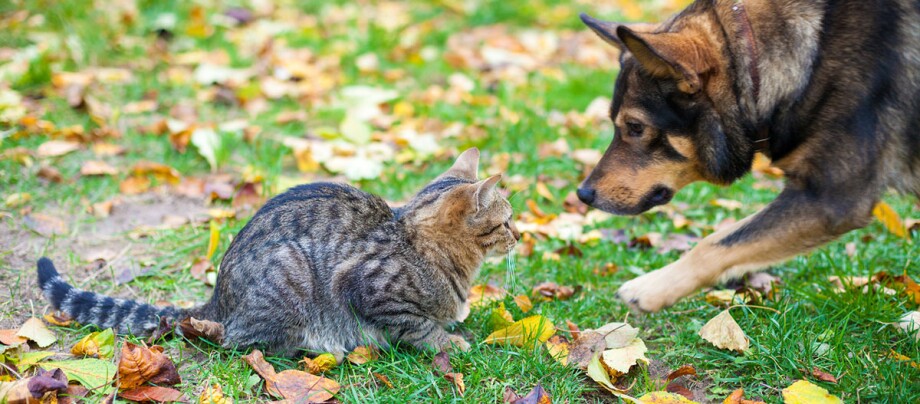Dog Chases Cats – Advice on How to Live Together More Peacefully
07.10.2022 - Reading time: 4 minutes

Dogs and cats aren’t exactly the best bedfellows. Yet, they can get on remarkably well with each other. You might ask yourself how? One dog might stay respectfully clear of cats, another will sleep on the sofa with them and a third may well hound them (pun intended). Read more about the causes of why dogs chase cats and how you can manage your dog’s behaviour here.
Why do dogs chase cats? What you should know
Wolves, the ancestors of dogs, have an instinct to hunt and this has been passed down to all pets without exception. The instinct may be very weak, almost non existent or extremely strong, as in the case of hunting dogs which have been specially bred for hundreds of years. The fact that these dogs chase cats is no surprise but why do dogs who show no other signs of this hunting instinct also set off in pursuit of any passing feline?
The reason initially rests upon the stimuli the cat gives the dog (unintentionally). The trigger of the sudden and quick movement is something all four-legged animals recognise, even when they have never shown much hunting instinct. By the way, cats react to the same trigger when it comes to mice. What’s more, your dog quickly learns that when they see a cat there is always a certain appeal (the chase). In other words, your dog “waits” for this because they’re excited by it. Some of our four-legged friends will bark with excitement at the cat, which is their way of trying to scare off the cat in order to experience the thrill of going after them.
What to do to prevent your dog from chasing cats
If you have a proper hunting dog, you should start with a complete anti-chase training. This requires a lot of patience and consistency but it is the only way to control your dog’s hunting instinct. If your dog is bothering cats as well as cyclists in the same way they are probably doing it out of frustration, stress, lack of social interaction or boredom. In order to correct this, it’s often enough to keep your dog occupied in the right way. (Agility, Clicker training).
If your dog has it in for cats in particular, you can initially start with one of three recommended methods. If these don’t work then anti-chase training is unavoidable for your dog.
Method 1: “Stop” command
The aim of this training is to teach your dog that leaving the cat alone is worthwhile for them. Take a treat in each hand. A special “super” treat can be hidden in the closed hand and a “normal” treat in the open hand which you can show to your dog. They will want the treat and nudge your hand. Use the command “leave” and ignore your dog and its advances. Every time the dog tries to get the treat from your hand, repeat “leave”. Once your dog calms down and maybe even sits in front of you, then you can immediately reward them with the super treat from your other hand.
Caution: Never use the first treat for this! This method is very important, otherwise you would be rewarding your dog with the treat that was previously not allowed.
Repeat this task several times a day until your dog understands the command “leave”. You can increase the difficulty by leaving the first treat on the ground in front of your feet. Only once the command is well understood can you move on to cats. For this keep your dog on a short lead and walk them past a cat sitting away in the distance. The command is given at the exact moment your dog starts showing the typical signs of being interested in the cat. Once the cat is ignored you can reward your dog.
Method 2: Pecking order
If your dog chases the house cat at home then they do not consider them as part of the “mixed pack”. The aim, therefore, is to make the dog aware of the cat’s rank in the house. To do this you need to teach your dog that the cat is above them in the pecking order.
Begin by initially greeting your cat in front of your dog and before them. Always give the cat food before the dog. If you’re giving them both treats, then repeat this, starting with the cat first. Create this hierarchy but without ignoring your dog. In no way should they become “jealous” of the cat since this will become a big red flag to them.


